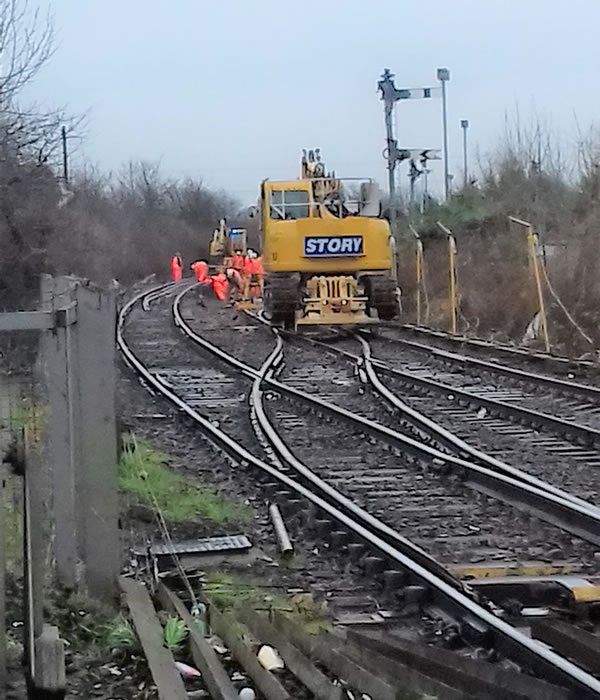This article was published in Rail Magazine issue number 891 November 6th - November 19th, 2019 under the heading “The Grip that Restricts Innovation and Rail Re-openings
DENNIS FANCETT, Chair of the South East Northumberland Rail User Group, draws on his former experience as Head of Major Customer Projects for a FTSE 100 company to examine Network Rail’s process for rail re-openings.
EVERY company needs a good project management process. Network Rail, with most of its work highly safety-critical, is no exception. It should be said that virtually every weekend of the year, Network Rail’s ‘Orange Army’ successfully completes dozens (if not hundreds) of small or mid-scale projects across the country. So, why then do I think that Network Rail’s GRIP (Governance for Railway Investment Projects) process is strangling market-led attempts to grow the railway - that is, opening or reopening new stretches of track and bringing isolated towns and villages back onto the national rail network?

You've heard of the wrong kind of snow. Last summer we also had the wrong kind of sun (our lines buckled and bent with mass cancellations and “advice not to travel" - but not in countries where it was even hotter). So now, to complete the hat-trick, I propose we also have the wrong kind of project management.
That’s because there are two types of project that an organisation might undertake. Firstly, there are internal projects. These are complex structural improvements that a company initiates and pays for itself, with the objective of making its business more profitable or able to sell more in the long term.
Then there are external projects. A customer wants to buy something that is complex, one-off, and will take several months (if not years) to deliver. The supplier works out how much it will cost to provide and how long it will take to deliver what the customer wants. If the customer decides to go ahead, he signs on the dotted line and the project is duly delivered.
In my own business of international telecommunications, an internal project might be building and launching a new satellite, laying another undersea cable, a new billing system, or a new international telephone exchange.
An external project might include a credit card company asking for a global network to validate a card transaction from any shop in the world at its UK computer suite within 1.5 seconds, a TV news channel needing to link outside broadcast teams to its studio, or a global brand wishing to join all its worldwide offices together with a seamless internal data network. In such cases, the customer approaches two or three suppliers and will choose from the best option it is offered. Both types of project need rigorous and robust processes strictly enforced by sound governance within the organisation.
For an internal project, the company needs to be absolutely clear that it really needs whatever is proposed, and must ask itself searching questions such as what will happen if it does nothing, or if there are emerging disruptive technologies that might completely change its business model and leave it with a pointless white elephant. And, critically, it needs to ask it its costs are under control.
These questions are re-examined by senior management at key stages throughout the project (often known as gateways), at which a decision might be made to modify or even abort a project rather than waste any more money. HS2, it would seem, is going through such a review right now.
External projects similarly need a robust process, and this normally falls into two stages. Firstly, there is the bid phase. This includes working out the best technical solution, how long it will take and how much it will cost, then adding a mark-up to get to the end price quoted to the customer. This information is collated into a formal bid or proposal which the customer is invited to accept and sign. Preparing the bid itself can take several months and can be very expensive, so the supplier first goes through a ‘bid / no bid’ decision in which it considers issues such as:
- Who is the competition?
- Does the supplier stand a realistic chance of winning this particular business?
- Does it have the resources to deliver the project successfully?
- Is the customer serious about going ahead with this proposal with funding in place?
In working out the price, it is vital to not include things the customer didn't ask for and doesn’t need, otherwise the supplier's price becomes uncompetitive and it won’t win the business. And due to the high cost of bidding, if a supplier loses too many bids it risks going out of business. There is therefore an inbuilt commercial imperative that keeps the price as low as possible.
But as soon as the customer signs on the dotted Line, the delivery phase itself commences - led by a project manager who ensures the work is delivered on time, within the internally agreed costs, and to the specified standard.
Within the project management process there are again built-in review points (normally referred to as milestones), at which progress, costs and customer satisfaction to date are all assessed. But the emphasis now is on whether or not senior management need to be alerted to clear obstacles threatening successful completion, and to allocate extra resources it needed.
It is almost unheard of for a customer to pay for their supplier's bid management costs as that is an overhead the supplier must absorb. It is similarly unheard of for a customer-initiated project to be aborted by a supplier mid-stream - in such an instance, the supplier knows its reputation will be in tatters across the industry sector and it won’t win any further business.
If indeed the supplier did get its sums wrong and finds it can't deliver the project within the cost anticipated, it simply has to take a hit and absorb the cost - apart from specific exceptions and force majeure clauses agreed by both parties in the contract.
So, back to Network Rail. In my opinion, NR's problem is that it is trying to apply an internal, company-initiated project management process to an external, customer-initiated project environment.
When a customer such as a local authority comes along and says: “We’d like to buy a new
rail connection between these two towns", Network Rail’s response is to say: “Wait! Are
you sure you really need to do this? Have you looked at other opportunities such as providing a bus link instead? Are you confident the population is going to grow in the way you predict? Let’s do a study on this, but you, Mr Customer, must pay for the study!"
These questions are appropriate it it’s an internally generated project, but not if a customer is standing there with his cheque-book open. What’s more, the customer is obliged to pay for his own bid costs, since all the work that Network Rail must do to work out the final price (stages 1 to 4 of the GRIP process) must be paid by the customer. A more commercially focused business would be only too keen to present the solution, work out the price, and take the business.
Plus, because NR has a monopoly, and there is no one else the local authority (or whoever wants the new rail link) can tum to, the hapless customer has no option but to pay up, The double whammy is both the unnecessary expense and the additional delay of having Network Rail check that the customer really does need whatever it just said it wanted.
To be fair, NR is entitled to ask some fairly penetrating questions right at the beginning, to ensure it is not wasting money in preparing the bid (working out the cost). So, we should expect to see it checking that the local authority has funding for the scheme, and that there is political support at leadership level. If Department for Transport funding is to be sought, then Network Rail is entitled to review the scheme against DfT’s funding criteria, to ensure the sponsoring body stands a good chance of getting that funding.
But it is not Network Rail’s job to second guess whether the sponsoring authority really does need the scheme, and whether it has looked at other options.
The Highways Agency has no remit to consider whether a new railway line would be better than a road upgrade, If it did, the Ashington rail reopening might be in place now, since the full reopening cost of £130 million is less than twice the £75m for the last upgrade to a single roundabout (Silverlink) in the corridor that the line will serve.
Likewise, when I go into my local sweetshop to buy a chocolate bar, the shopkeeper doesn't look me up and down, notice I'm a bit overweight, and suggest I pop round to the greengrocers next door and buy an apple instead. He is only too pleased to sell me his own product, because he knows that if he doesn't, he will eventually go out of business. Nor should Network Rail be including in the price quoted to the customer things that it needs to do anyway, regardless of whether or not the customer goes ahead. This tendency comes from a failure to differentiate between intimal and extremal projects.
ln the case of the Ashington reopening, the debate has been around the cost of upgrading the line to ERTMS signalling. As it is a working freight line, this has to be done anyway regardless of whether or not passenger services are returned. It is therefore not part of the cost of bringing back passenger trains, and loading it in makes Network Rail’s quote ridiculously expensive.
But with no competitor on hand to offer a more realistic figure, there is no commercial driver on Network Rail that flushes this out. The hapless customer has no choice but to bear with the process and pay up.
Who in Network Rail is targeted with growing the railway, and who will receive an end-of-year bonus proportionate to the number of track miles added or new stations opened?
I suspect no one. And that most likely accounts for why Network Rail shows no appetite to be helpful or to grow its business. Its state-owned monopoly structure means it has no risk of losing business to a competitor, thus no internal driver that forces it to change. What's the answer? Some say privatise, but I don’t think it’s as easy as that. A privatised Network Rail would still most likely be a monopoly or several smaller regional ones.
For me, it's a question of change the process, not change the company structure. Let’s have a system which recognises that there are external paying customers out there wanting to buy Network Rail's product. Streamline the process of giving a price and solution, make sure that it is as affordable as possible by keeping out unnecessary bells and whistles, and let the orders roll in.
Back to More...








